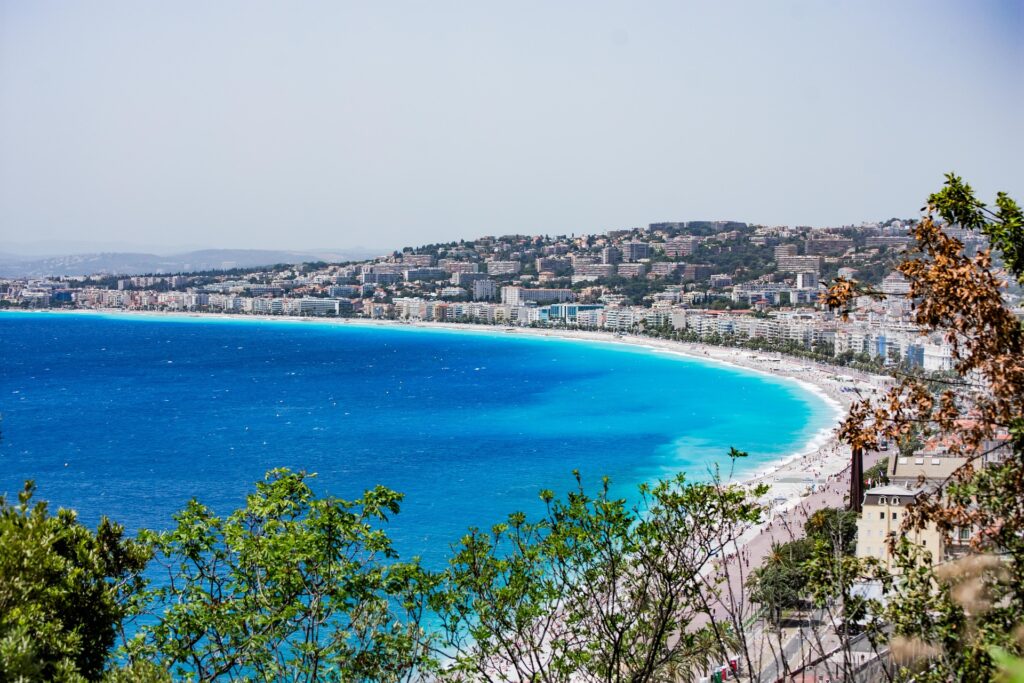Venice with kids had been on our travel wish list for a while, and this April school break felt like the perfect time to go. We planned a double city break – 4 days in Venice followed by 4 days in Florence – traveling between the two by train. With our two kids, aged 5 and 9, we set out to explore Venice’s winding streets, famous sights, and bustling canals (with plenty of gelato stops along the way). Here’s how we spent 4 days in Venice with kids – what we did, what worked well, and a few things we’d plan differently next time.
1. Getting to Venice with Kids
We flew into Venice Marco Polo Airport from Paris on EasyJet, without booking any airport transfers in advance. Luckily, getting from the airport to Venice itself turned out to be simple, affordable, and surprisingly efficient.
After landing, we bought tickets for the ATVO express coach right at the airport – €10 per adult, with kids aged 5 and under travelling free. These buses run roughly every 15–30 minutes and take you directly from the airport to Piazzale Roma, which is the main bus terminal on Venice Island (the historic part of the city). The journey took about 20 minutes, and there’s dedicated luggage storage under the bus, which made it very manageable with kids and bags. Just don’t forget to validate your ticket at the small stamping machine next to the bus stop before boarding.
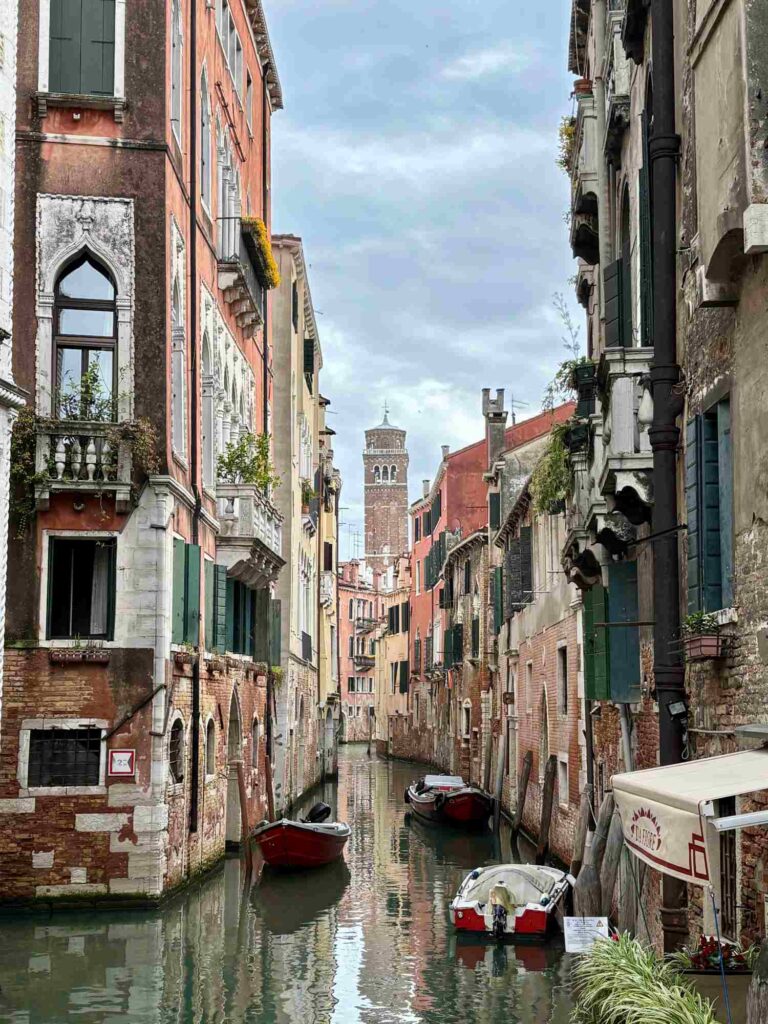

Once you arrive at Piazzale Roma, you’re officially on Venice Island – and here’s where your travel choices open up:
How to Get from Piazzale Roma to Your Hotel or Rental
Depending on where you’re staying, there are a few options:
- Walking – Venice is a walking city, and if your accommodation is nearby (as ours was), you can go on foot. That said, allow extra time – Google Maps may say 10 minutes, but with bridges, steps, luggage, and stopping to take photos every 3 seconds (guilty!), it may take longer.
- Vaporetto (water bus) – If you’re staying farther away or want a fun, scenic ride to ease in, the vaporetto is a great option. Line 1 follows the Grand Canal and stops frequently – ideal if you want to enjoy the sights right away. Tickets cost €9.50 per ride (valid for 75 minutes), and kids under 6 travel free. You can also buy multi-day passes (48h, 72h, etc.) at the machines at the terminal.
- Water Taxi – This is the quickest and most glamorous (and expensive) option. Think private boat straight to your doorstep. Prices start around €70–100 depending on distance, and for families with lots of luggage or staying far from a vaporetto stop, it can be worth it for the convenience.
- Traghetto (gondola ferry) – Not a transfer option from Piazzale Roma, but worth knowing: for short crossings over the Grand Canal where there’s no nearby bridge, these gondola-like ferries charge just a few euros. They’re handy later in your trip if you’re walking a lot.
For us, our apartment was a 10-minute walk from the bus station. Although with all the charming bridges, twisty lanes, and photo stops, it took us closer to 30. That first walk was part of the fun: quiet streets, beautiful facades, and our first real taste of being in Venice.
2. Where to Stay in Venice with Kids
If you’re staying in Venice for a few days, I recommend choosing a quieter neighbourhood like Cannaregio, Dorsoduro or Castello. These areas feel more local, which is a big plus after a day navigating Venice’s busy alleys and piazzas. Just keep in mind you’ll need to walk more or take vaporetto rides to get to the main landmarks.
If you’re only in Venice with kids for a night or two and want maximum convenience, it makes sense to stay closer to the action in San Marco or San Polo. You’ll step out of your hotel right into Venice’s liveliest areas, which is great for squeezing in sightseeing. Just be prepared for crowds as soon as you step outside.
Where We Stayed in Venice
We booked one of the Rialto Project Apartments through Wonderful Italy. It turned out to be great setup for a family of four. The apartment had two bedrooms, a living room, and a kitchen – perfect for slow mornings, easy breakfasts, and having space to unwind. Our kids had their own room, which helped with sleep and downtime. It wasn’t luxurious, but it was clean, well-equipped, and comfortable. The location worked really well for us. It was quiet and residential, with local restaurants and supermarkets nearby, yet only a 15-minute walk to St. Mark’s Square. After busy days out, it was a relief to come back to a peaceful part of the city.
Note for families: the apartment was on the third floor with no lift. It was fine for us, but worth checking in advance if stairs might be an issue for you. Most of Venice apartments don’t have elevators, so it’s something to be aware of when booking.
Family-friendly Hotels in Venice
If you prefer the convenience of a hotel and the guarantee of an elevator (and we’ll probably do just that next time!), here are some top-rated family-friendly options to consider. If you want to be right in the heart of the action, just a few minutes from St. Mark’s Square, Hotel Splendid Venice is a good choice, with elegant rooms and handy extras like stroller rentals. Over in Cannaregio, Hotel Carnival Palace is closer to the train station and offers spacious family rooms that can sleep up to six – perfect if you’re traveling with a bigger crew. For more space and resort-style amenities, JW Marriott Venice Resort & Spa, set on its own private island, offers a kids’ club, family pool, and lots of green space for little ones to run around and explore.
3. How We Spent 4 days in Venice with Kids
Day 1: St Mark’s Square, Doge’s Palace, Gondola Ride

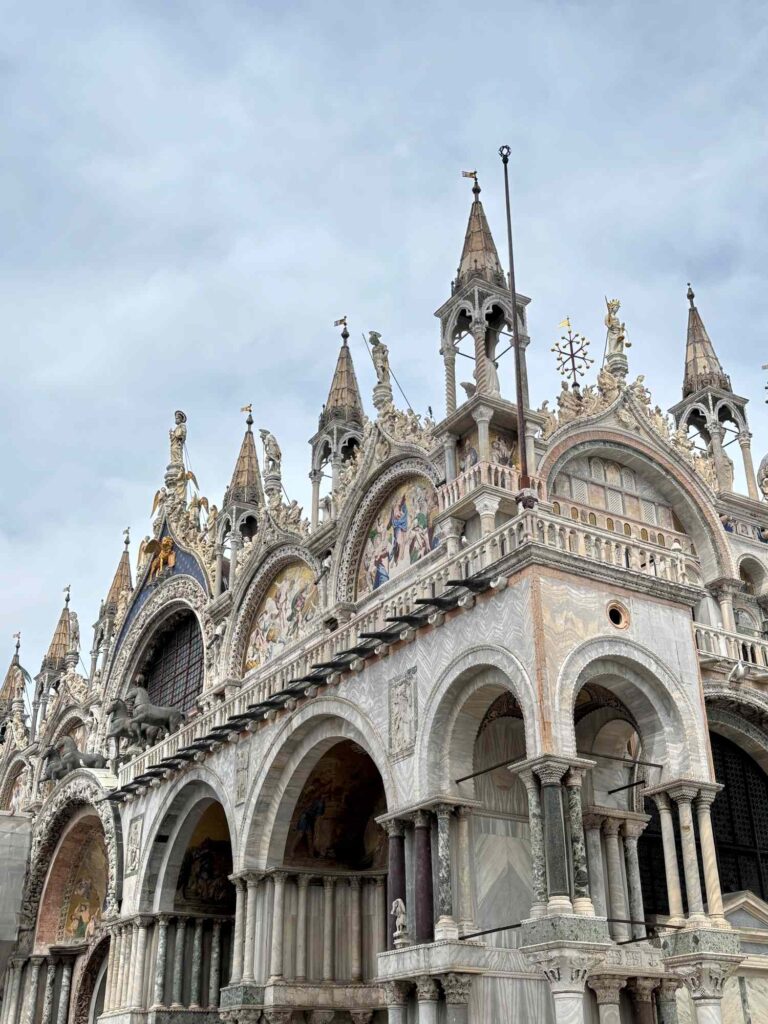
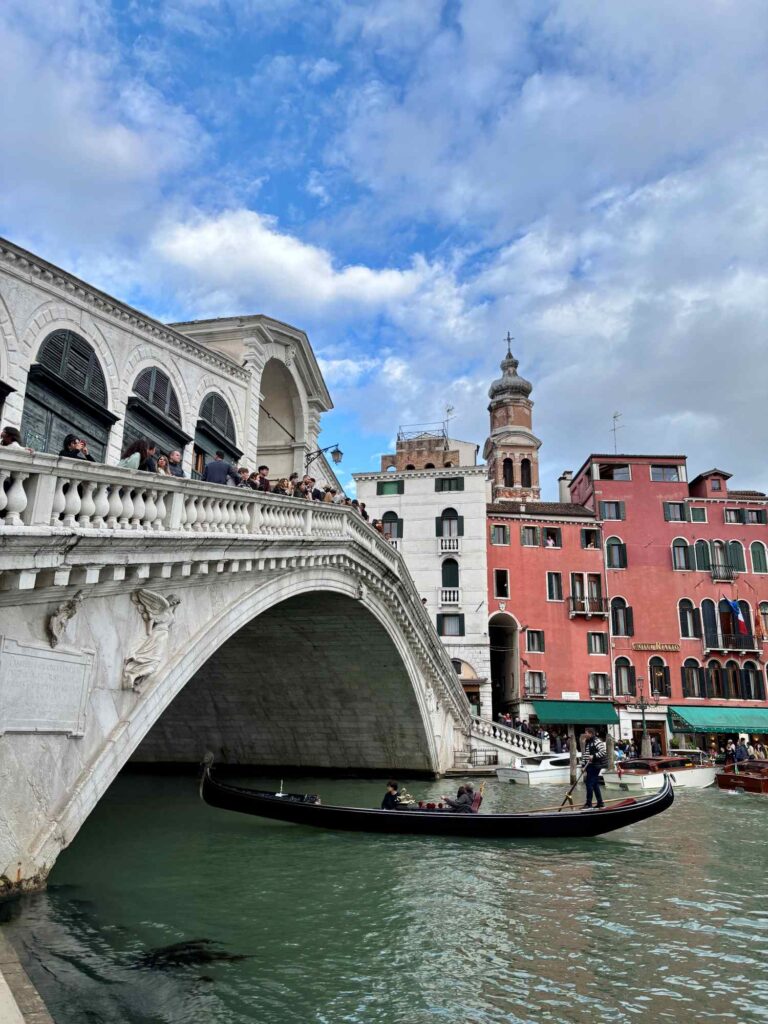
We arrived in Venice the night before and immediately headed out for a stroll around the city, soaking in our first views of the canals and alleyways bathed in golden evening light. Dinner was at Al Gobbo di Rialto, where we had some excellent seafood pasta and a tiramisu that disappeared in minutes. Before heading back, we popped into a local supermarket to pick up breakfast supplies for the week – something we always try to do when staying in a rental apartment.
Waking up the next morning, we were excited to dive into the heart of Venice. With two curious kids (aged 5 and 9), our plan was to hit the city’s most iconic sights first. We started at the city’s most famous square:
St Mark’s Basilica (Basilica di San Marco)
We arrived at Piazza San Marco around 9:30am, hoping to beat the crowds to St Mark’s Basilica – Venice’s most iconic church. It’s one of the finest examples of Italo-Byzantine architecture, originally built in the 9th century to house the relics of Saint Mark, which were (allegedly) smuggled into Venice from Alexandria under layers of pork to evade Muslim customs inspectors. The current version of the basilica, with its golden mosaics, marble columns, and five majestic domes, was completed in the 11th century and has stood as a symbol of Venetian wealth and pride ever since.
Unfortunately, the church was closed for the day – with no explanation. It was disappointing, but these things happen in Venice, and it’s always good to have a Plan B. Even from the outside, the facade of the basilica is extraordinary, filled with intricately sculpted animals and shimmering gold mosaics. We pointed out lions, horses, and saints in the stonework to the kids.
Tip: Entry to the basilica is free, but lines can get very long. You can pay a small fee to reserve a timed-entry skip-the-line ticket to St Mark’s Basilica or book a guided tour that includes the basilica and terrace. Wear modest clothing when you go inside – shoulders and knees should be covered.
Doge’s Palace (Palazzo Ducale)
Since the basilica was closed, we headed next door to the Doge’s Palace, one of Venice’s most important historical landmarks. For centuries, this building was the heart of the Venetian Republic. It served as the Doge’s residence, the seat of government, the courthouse, and the prison. Today, it’s a museum that offers a fascinating window into how Venice once ruled the seas.
I had debated whether to prebook skip-the-line tickets to the Doge’s Palace, but I’m glad we didn’t. We arrived around 10am and there were only two people ahead of us in the regular ticket line. The palace has two queues: one for prebooked tickets, and one for walk-ups. We bought standard entry tickets on the spot and were inside in minutes. If you plan on visiting multiple museums during your stay, it’s worth looking into the Venice Museum Pass, which includes the Doge’s Palace.
Inside, we wandered through the grand halls used for political meetings and council sessions, all richly decorated with massive paintings. The sheer size of the rooms – and the ceilings – was impressive, even for the kids. While the art and architecture are stunning, what really caught our children’s interest was the prison section. To reach the prison, you walk through the Bridge of Sighs. Even if your kids aren’t museum fans, this part of the Doge’s Palace can really capture their imagination, especially if you pepper in a few creepy prison stories or tales of the infamous Casanova, who once escaped from these very cells.
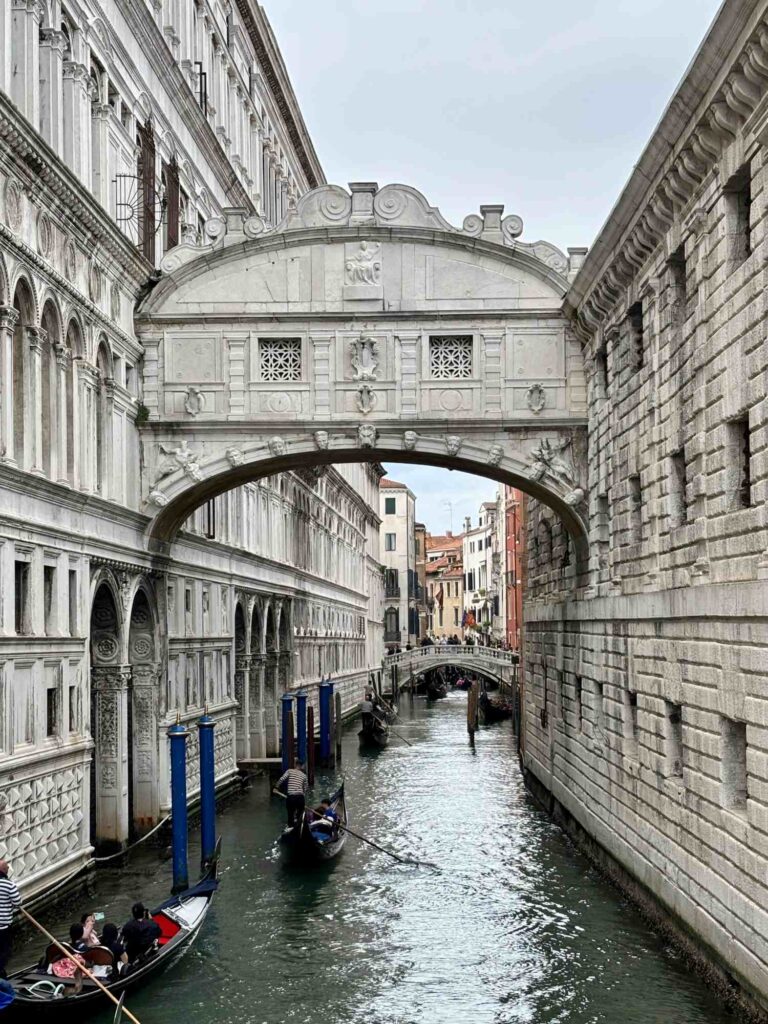
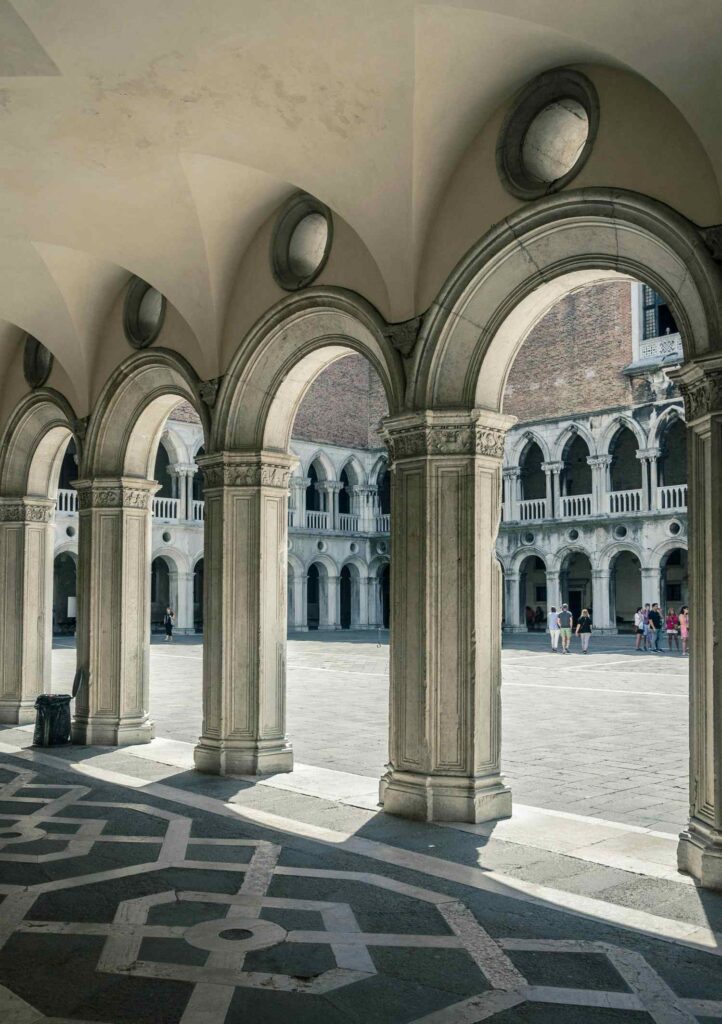
The Bridge of Sighs
After exploring the cold, narrow prison corridors and imagining the lives of the inmates, we exited back into the sunlight and walked around the palace to get a view of the Bridge of Sighs from the outside – the classic spot for photos.
The Bridge of Sighs is one of the most iconic structures in Venice. From the outside, it’s a beautiful arched bridge made of white limestone, suspended high above the canal that separates the palace from the old prison. But from the inside, it’s far more sobering. The bridge earned its name from the idea that prisoners would sigh as they crossed it – taking in their last glimpse of Venice through the tiny stone-grilled windows – on their way to their cells.
Tip: If your kids are old enough and interested in stories from the past, the Secret Itineraries Guided Tour could be a great option. It includes access to hidden chambers and the legendary escape route of Casanova.
Lunch, Gelato & Mask Shops
After the palace, we were ready for lunch. Luckily, the walk there turned into a mini adventure. We stopped frequently to look in shops along the way, including a beautiful stationery and ink stores and several Venetian mask shops. The kids loved peering at the elaborate masks through the windows, and we had fun spotting the difference between mass-produced masks (often made abroad) and the handcrafted ones made on-site by local artisans.
Lunch was a relaxed, pasta-heavy affair at a small trattoria (nothing fancy, just good food). We skipped dessert because we already had gelato on our minds, and made a beeline to Gelo Artigiani del Gelato, a small takeaway-only gelateria with creative flavours and an open kitchen where you can see the gelato being made. They were the first in Vencie to experiment with gelato cooled with liquid nitrogen. Highly recommend.
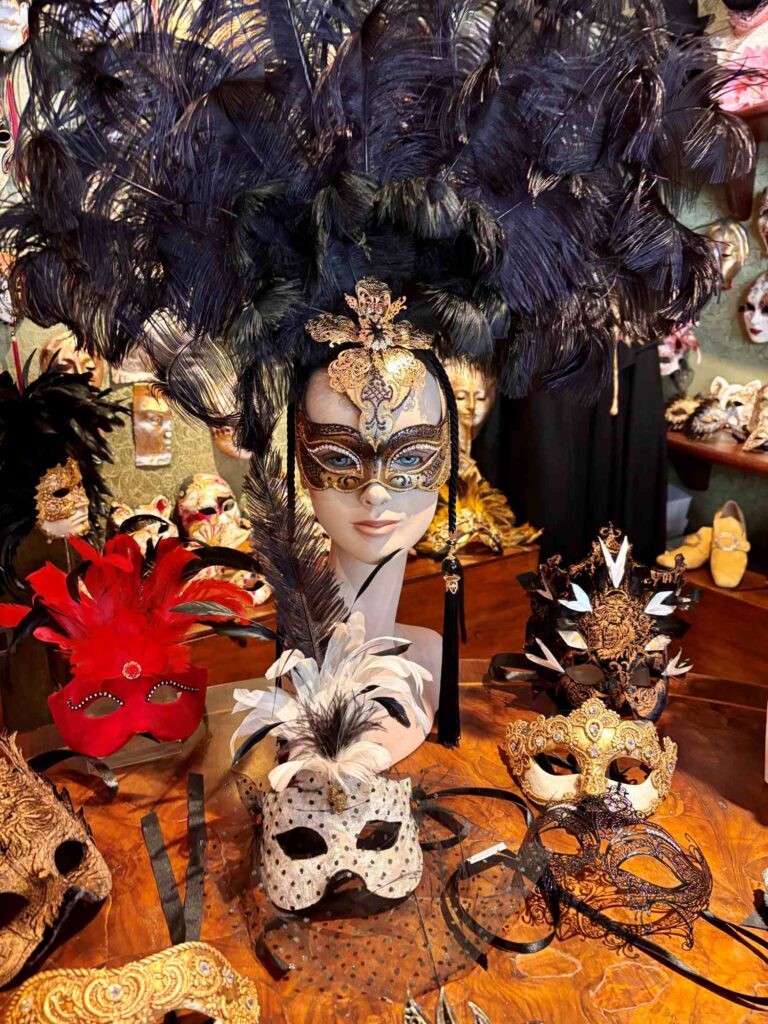
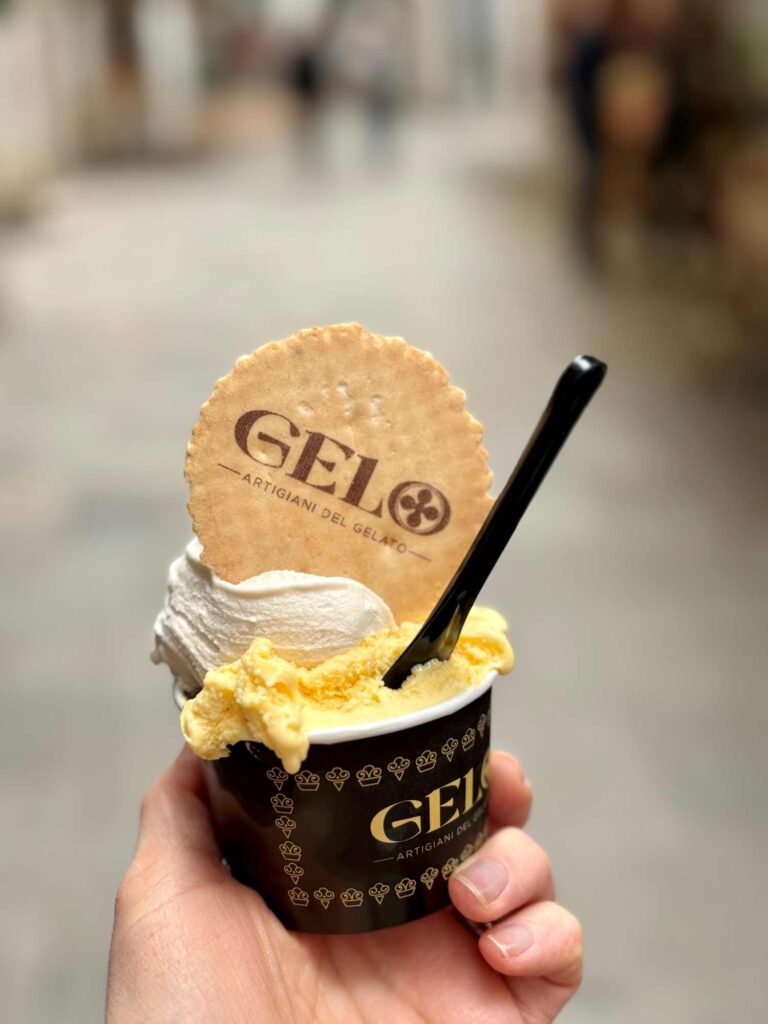
Libreria Acqua Alta – Instagram vs Reality
Next, we visited one of Venice’s most Instagrammed spots: Libreria Acqua Alta, the famous “floating bookshop” where books are stored in bathtubs and gondolas to protect them from Venice’s notorious flooding (acqua alta). It’s an undeniably unique place, but to be honest – I found it overrated. There was a long line to enter, and once inside, it was a bit chaotic. The flow of tourists being pushed through made it hard to browse, and we didn’t feel encouraged to linger or buy anything. The idea is cool, but the reality felt more like a tourist funnel than a bookshop.
Gondola Ride – The Venice Classic That’s Actually Worth It
After lunch, we were ready for what would become one of the absolute highlights of the trip: a gondola ride. Yes, it’s expensive. Yes, it’s touristy. But it was also incredibly memorable, and I’d do it again in a heartbeat.
Here’s what to know: Gondolas operate from set “stations” throughout the city, and the price is fixed at €90 for 30 minutes (as of 2025), cash only. Prices are set by the city, not the gondoliers. If you go near St. Mark’s or the Rialto Bridge, you’ll likely find gondolas quickly. But be warned – they’ll take you on the Grand Canal, which is crowded with everything from water taxis to ambulances. Not the peaceful ride we wanted.
Instead, we walked for nearly an hour from one station to the next looking for a gondolier who would take us through the quieter canals. At most stops, there are only 1–2 gondolas available, so if one’s just left, you may have to wait for it to return. But eventually, third time lucky, we found one. Our gondolier didn’t talk much, but he did point out a few buildings along the way. The experience of gliding through the narrow, serene back canals was magical. You see the city from a completely different angle.
Wandering & Getting Lost (On Purpose)
With no set plans for the rest of the afternoon, we wandered. Venice is one of the few cities where getting lost is the plan. Around every corner is a tiny bridge, a quiet canal, or a surprise piazza. The big bridges, like the Rialto Bridge and Ponte dell’Accademia, are beautiful but crowded, so we mostly stuck to the smaller bridges where we had the views (and space) all to ourselves.
We stumbled upon a genuine mask-making shop, where we learned that they offer daily workshops for kids and adults. Sadly, they were fully booked for the next two months. Next time, we’ll absolutely book a Venice mask making workshop ahead. If you’ve got creative kids, this is a fantastic hands-on way to learn about Carnival masks, Venetian art, and local craft traditions.
St Mark’s at Night
In the evening, we made our way back to St. Mark’s Square. Seeing it at night was a completely different experience. Gone were the daytime crowds. The basilica and the palace were softly illuminated, and with far fewer people around, we could actually take in the details and enjoy the space. The two main cafés lining the square, Caffè Florian and Gran Caffè Quadri, had guests seated outside on their terraces, and each had its own small live band playing under the colonnades.
Simply walking through the square, listening to the music and soaking in the ambiance, made for a really lovely evening stroll. It’s absolutely worth visiting St. Mark’s after dark, even if just to enjoy the contrast from the daytime hustle.
Day 2: Burano & Torcello Island Day Trip
Today we left the main island of Venice behind and headed out to explore the colourful fishing villages and backwaters of the Venetian Lagoon. Our original plan was to Do a Day Trip from Venice with Kids: Murano, Burano & Torcello, all in one day. However, that turned out to be way too ambitious. With kids and meal stops it made much more sense to take our time and split the islands across two days. So we started with Burano and Torcello, saving Murano for the next morning.
Getting to the Islands
We walked to the Fondamente Nove vaporetto stop and took Line 12, which loops between Venice and the outer islands. Tickets can be bought at the ACTV machines near the vaporetto stops. Boats run roughly every 30 minutes, and the ride to Burano takes about 40–45 minutes, stopping in Murano and Mazzorbo along the way.
Tip: We used the Citymapper app, which worked surprisingly well for vaporetto times. I also cross-checked with a local app called CheBateo?, which is designed specifically for Venice’s boat network.
Burano: Venice’s Most Colourful Island
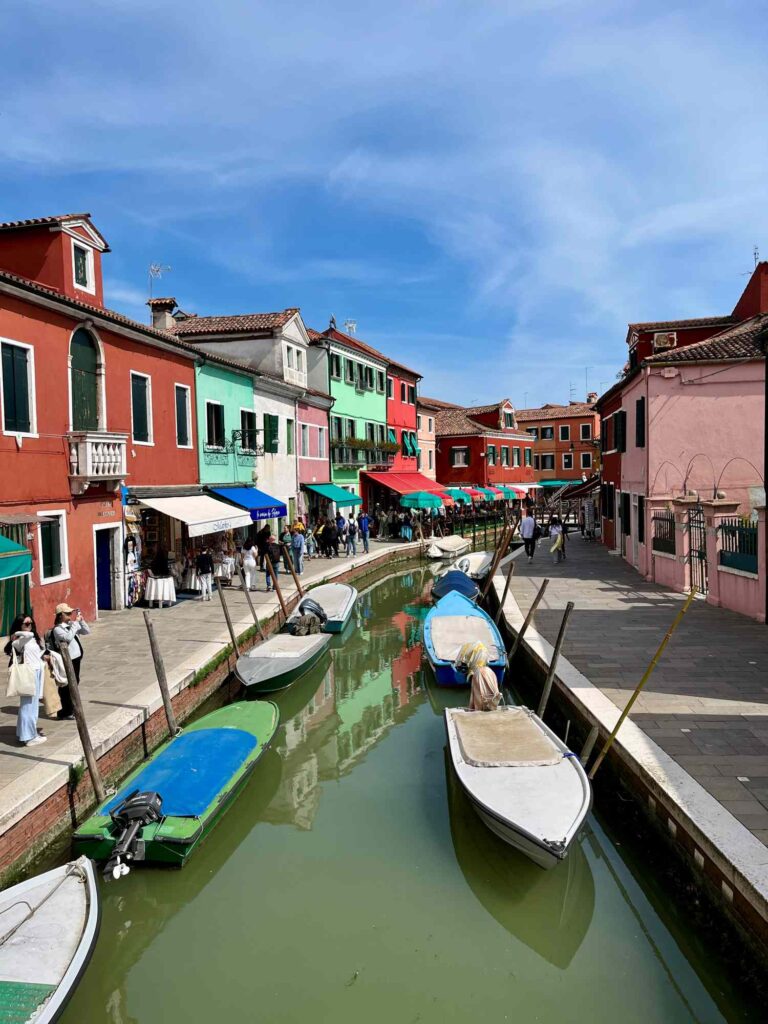
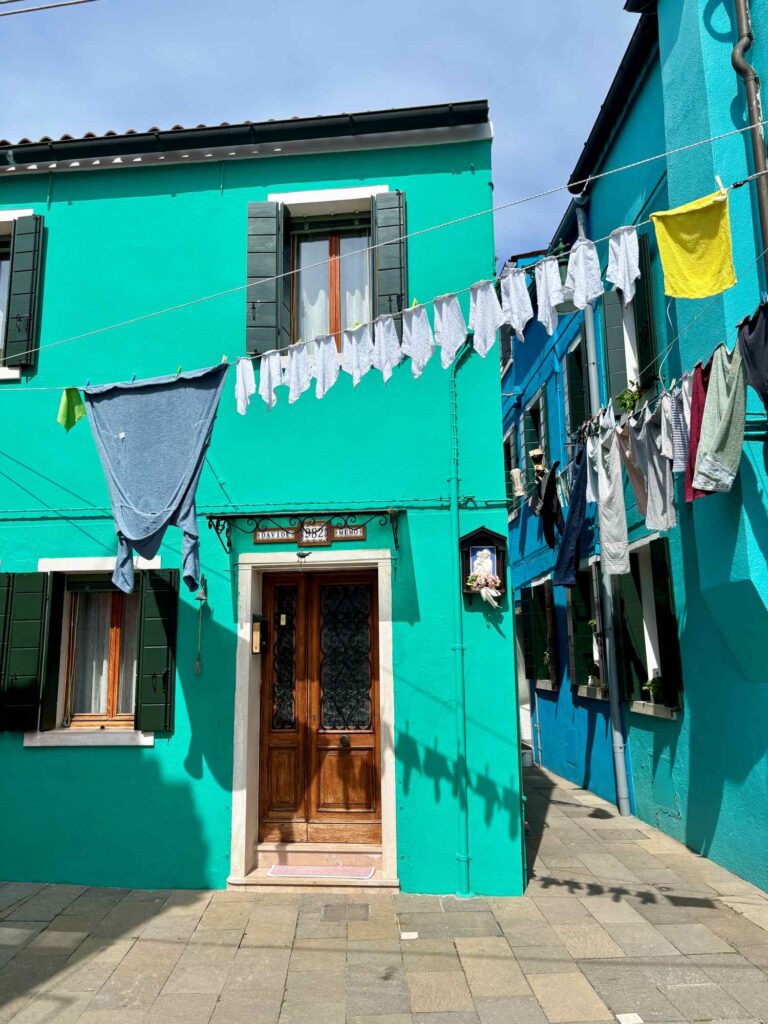
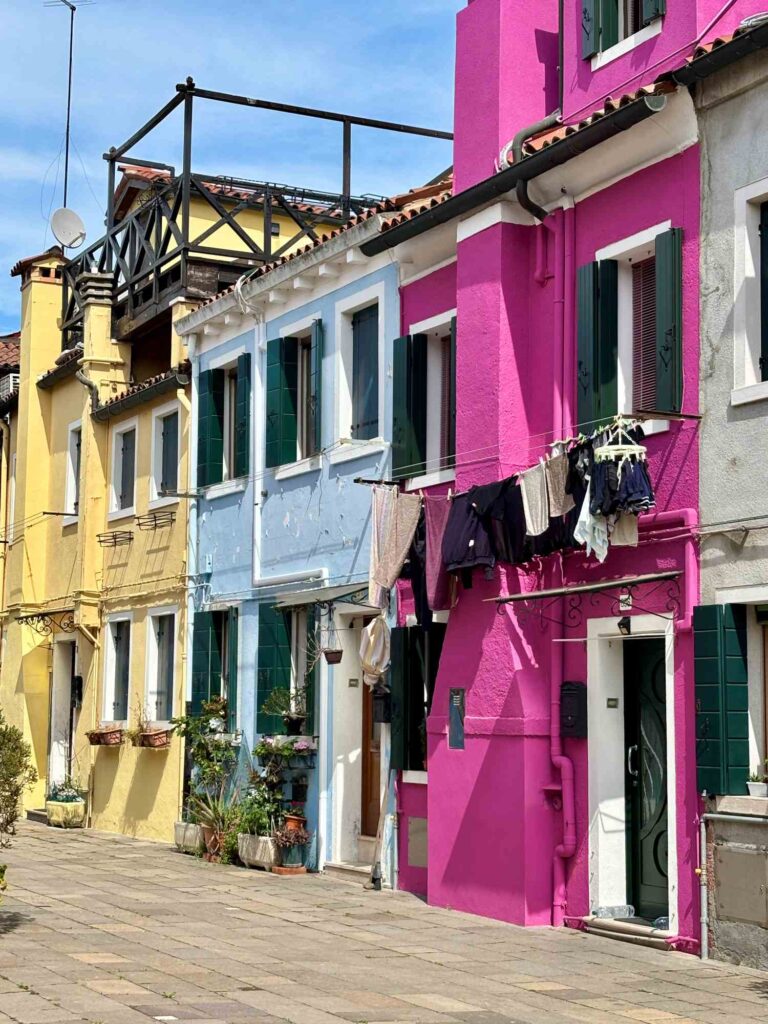
We arrived in Burano around 10:30am on a Friday, and it was already busy. But even with the crowds, it’s an absolute feast for the eyes. The whole island is a patchwork of brightly painted houses – red, turquoise, lavender, mustard – lining canals and cobbled lanes. Legend has it the fishermen painted their homes in bold colours so they could find them in thick lagoon fog. Whatever the reason, it works. Burano is stunning.
Burano is also known for its lace-making tradition, which dates back to the 16th century. While most of the lace sold today is machine-made or imported, a few shops still sell handmade lace by local artisans. That said, our kids were (understandably) more interested in gelato and cookies than lace.
We didn’t rush. We spent close to four hours here, wandering beyond the busy main street and into the quieter parts of the island. The side canals were peaceful, the colours just as vivid, and the kids loved spotting laundry hanging out to dry above the water, somehow charming in Burano, even if you’d never think twice about it at home.
Lunch at Da Romano
Lunch was at Da Romano, a well-known spot on the island with a long family history, celebrity clientele and a reputation for its seafood risotto. I had originally tried to book a table at another popular restaurant, Trattoria al Gatto Nero, that was full, but I’m so glad we ended up here instead. The food and service were excellent. We sat at a table outside, watching the world go by with glasses of local white wine while the kids happily tucked into pasta.
Bussolà Cookies & Gelato Break
After lunch, we stopped for gelato at Gelateria Crema, just down the street. Then popped into the bakery next door, Panificio Pasticceria Palmisano, for Bussolà, Burano’s iconic butter cookies. We bought a bag of the classic S-shaped ones, though they also come in round spirals. Rich, eggy, and just sweet enough, they made the perfect takeaway treat.
We found a sunny spot along the canal to sit, snack, and soak up the view. It was one of those simple travel moments that ends up being a favourite – no museum, no agenda, just watching boats glide past while the kids waved to everyone.
Torcello: Venice’s Ancient Soul
Next, we hopped on vaporetto Line 9 for the quick 5-minute ride to Torcello.This tiny, rural island that couldn’t feel more different from the rest of Venice. While it’s quiet today, Torcello was actually the original settlement in the lagoon, dating back to Roman times. At its peak, it was home to over 20,000 people. Today, fewer than 20 residents remain. There’s just one road, a footpath along a canal that leads from the vaporetto dock to the island’s historic centre. On the way, we passed a small playground, which gave the kids a much-needed runaround after all the walking.
Torcello’s main attraction is the Cathedral of Santa Maria Assunta, originally founded in 639 AD and rebuilt in the 11th century. Just past the churches is the Ponte del Diavolo (“Devil’s Bridge”), a small stone bridge with no railings and a mysterious name. According to local legend, the devil built it in a single night. The kids were intrigued, and it made for a great little detour and photo op.
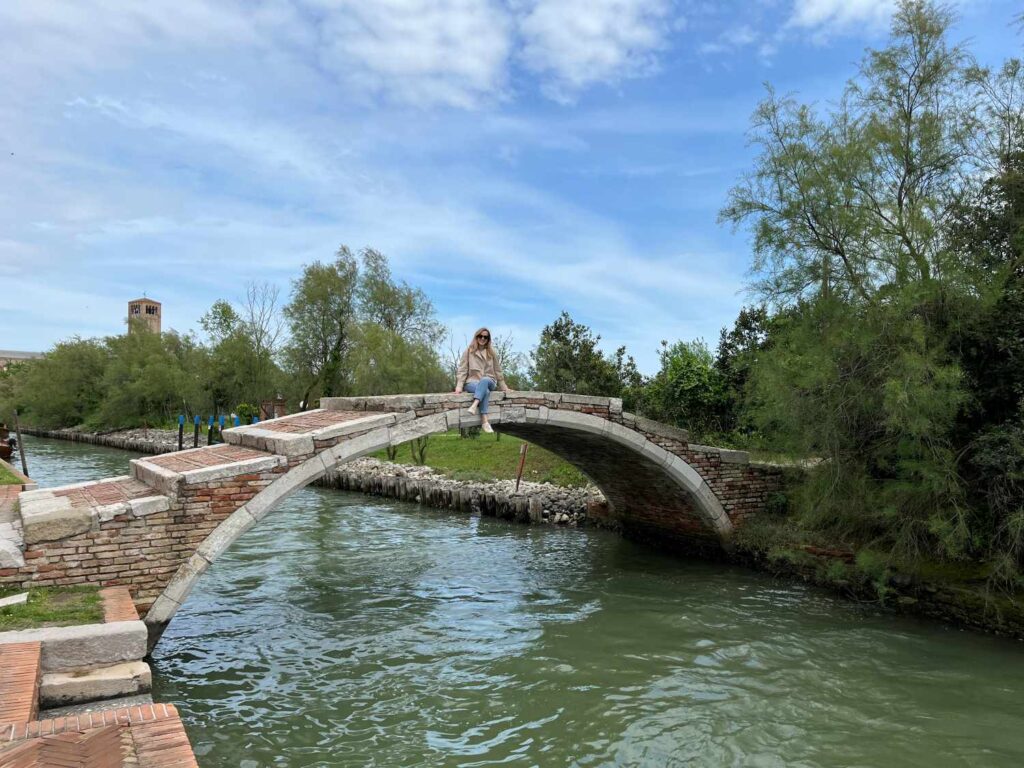

No Murano (Yet)
By the time we finished in Torcello, it was already 4:30pm, and we realised there was no point heading to Murano that late in the day. Most of the glass workshops and demonstrations close around 5pm, and we didn’t want to rush through or arrive just in time to see the doors shut. So we made the decision to push Murano to the next morning. We retraced our steps: boat back to Burano, then transferred back to Venice. It took about 45 minutes total to get home, but the ride was lovely with the sun low in the sky.
Day 3: Murano, St. Mark’s Bell Tower and a Grand Canal Cruise
After spending the previous day soaking in the colours of Burano and the calm of Torcello, today was all about Murano, Venice’s legendary glass island. We set off from the same vaporetto stop at Fondamente Nove, hopping on Line 12 again for the short ride over.
Murano: Glassmaking Island of the Lagoon
Murano is a cluster of small islands connected by bridges, and it’s world-famous for one thing: glass. In the 13th century, Venice moved all its glass furnaces to Murano, partly to prevent fires in the city and partly to protect the secrets of its prized glassmaking techniques. The island has been known for its artisans ever since, and although tourism now dominates, the legacy is still very much alive.
Visually, Murano isn’t as vibrant or charming as Burano. The houses are more subdued, and the canals are a bit wider and less photogenic. But it’s still beautiful in its own way, especially if you like browsing local crafts and window shopping for shimmering glass chandeliers, jewellery, and ornaments.
Glassblowing Demonstration at OMG
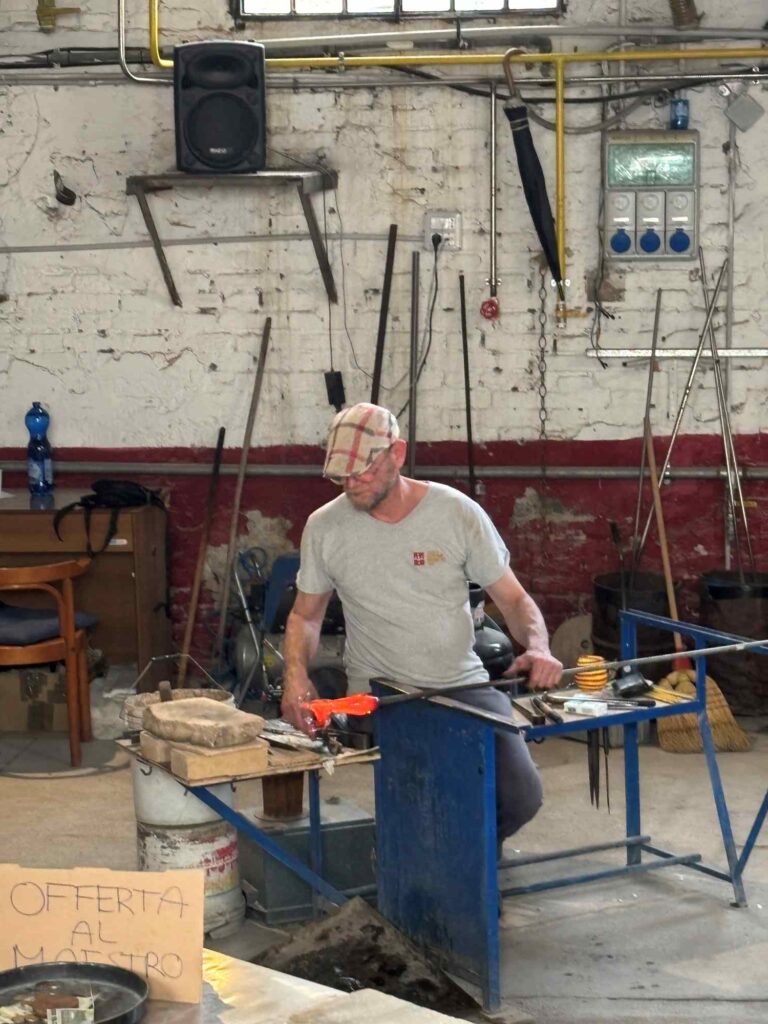
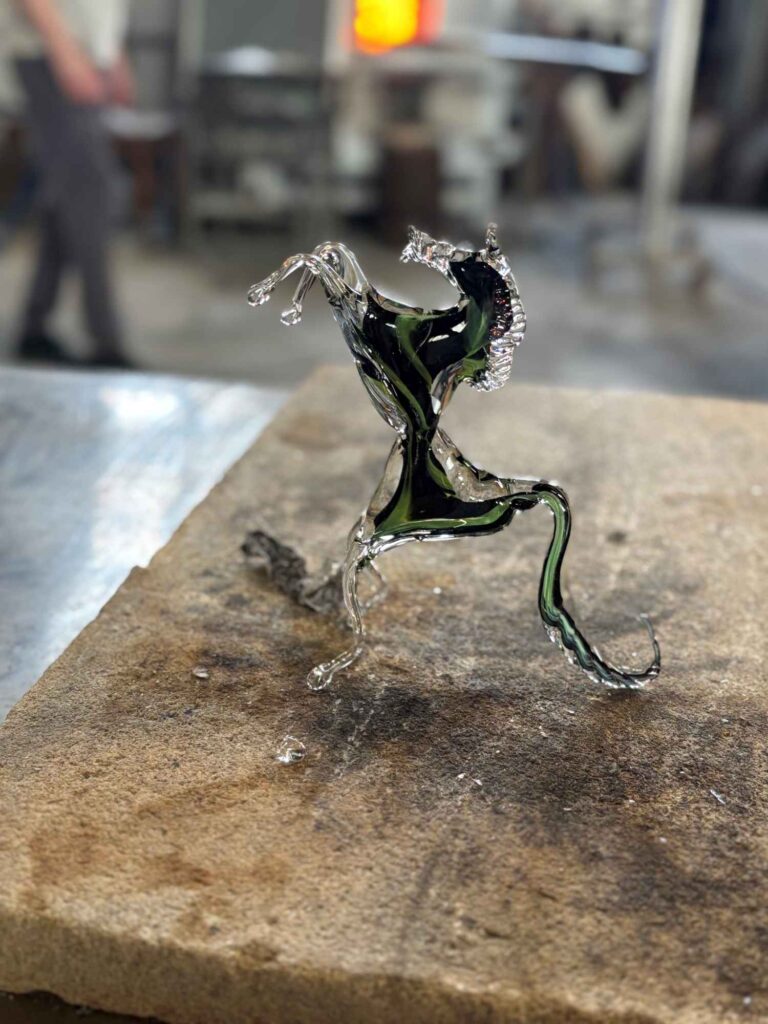
We didn’t book a glass blowing demonstration in advance. We simply walked to OMG (Original Murano Glass), one of the well-known demonstration workshops, located near the lighthouse on the far side of the island. Entry was €5 per person, and no reservation was needed.
The demonstration lasted about 15 minutes, with brief explanations in Italian and English. It wasn’t overly detailed or in-depth, but it was enough to give the kids a glimpse into the glassblowing process. Rather than making something basic like a bowl or a vase, the glass master created an intricate horse figurine, shaping it out of molten glass with long tweezers and incredible precision. After the demo, we exited through the gift shop (naturally). While the pieces were impressive, prices were steep, and honestly, we didn’t see much we hadn’t already seen in the smaller shops scattered around Murano. Still, it’s a fun stop if you want to see glassblowing in action, especially with kids.
OMG isn’t the only glass factory offering demonstrations. There are several others on Murano, but it is one of the most prominent. They run frequent shows and often accept walk-ins without advance tickets, depending on timing and crowd levels. Their website does recommend booking ahead, so if you want a guaranteed time slot, it’s best to prebook.
Lunch & Local Shopping in Murano
We didn’t have a lunch reservation, so we just wandered until we found somewhere that looked good – Ristorante alla Vecchia Pescheria. It had a shaded outdoor terrace right by the canal and was perfect for a family lunch. A relaxed spot, simple but tasty food. The kids were happy, and so were we.
After lunch, we browsed a few more shops. I really wanted to bring home some glassware made from authentic Murano glass. I ended up choosing a set of beautiful glasses and a flower vase, and paid around €30 to have them shipped to our home in Paris. Considering the fragility and speed of the delivery, I thought that was a fair price.
Climbing the Campanile (St. Mark’s Bell Tower)
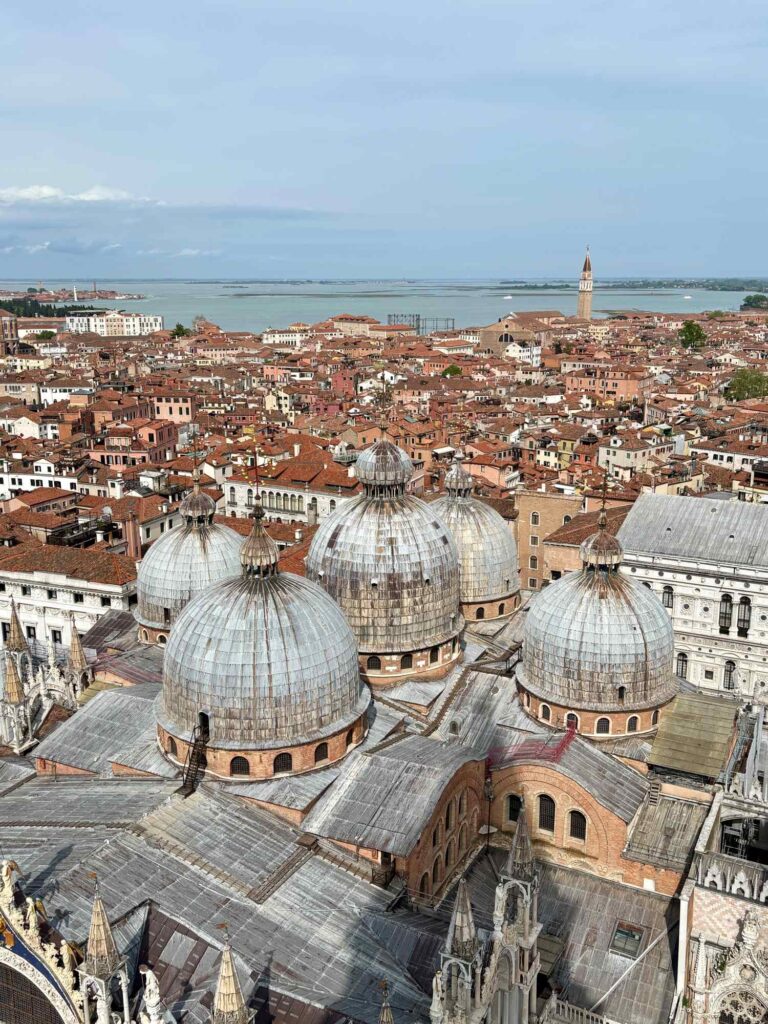

We took the vaporetto back and got off at San Marco, hoping to finally visit St. Mark’s Basilica. No luck. For the second time, it was closed for the entire day with no clear explanation. Definitely one of those Venice quirks you just have to accept. Since we were already in the square, we decided to go up the Campanile di San Marco. The iconic bell tower that dominates the Venice skyline. Originally built in the 12th century, the current version is a reconstruction from 1912, after the original tower collapsed (spectacularly) in 1902. From the top, you get 360-degree views across the city and the lagoon.
We didn’t have skip-the-line tickets to Campanile, so we queued in the general line. It moved steadily, and we were at the top in about 30 minutes. There’s an elevator all the way up, so it’s totally doable with kids and no climbing involved. The kids loved spotting places we’d already visited, peering through the viewing telescopes, and pointing out tiny boats zipping around the canals below.
Tip: For an alternative (and less crowded) viewpoint of Venice, take a vaporetto to the Church of San Giorgio Maggiore, which you can see just across the water from St. Mark’s Square. There’s an elevator to the top of the bell tower, and the views are said to be spectacular, offering a sweeping panorama of St. Mark’s Square, the Grand Canal, and the Venetian Lagoon. If we’d had more time, I would’ve loved to fit this one in.
Vaporetto Down the Grand Canal
From San Marco, we hopped on vaporetto (water bus) Line 1 and cruised up the Grand Canal, Venice’s version of a river cruise. The ride took us past some of the city’s most iconic palazzos and bridges. Getting around is definitely part of the fun when you’re in Venice.
Tip: Try to grab a seat on the open-air side deck for the best views.
For dinner, we stayed close – just a few doors down from our apartment at Muro Frari. This was a great little neighbourhood spot well away from the tourist trail. Relaxed atmosphere, good food, and very kid-friendly. A perfect, low-key way to end the day.
Day 4: A Morning in the Jewish Ghetto
For our last morning in Venice, we checked out of our apartment and headed to Santa Lucia train station. There, we left our luggage in the left luggage facility just before the entrance to the station. It’s super handy if you have a few hours to explore before your train. A smaller suitcase costs only €5 to store for the whole day, and €8 for a larger suitcase.
With a few hours to spare before our train to Florence, we decided to take a short walk to one of Venice’s most historically rich and often overlooked areas: the Jewish Ghetto. It’s located just five minutes from the train station in the Cannaregio district.
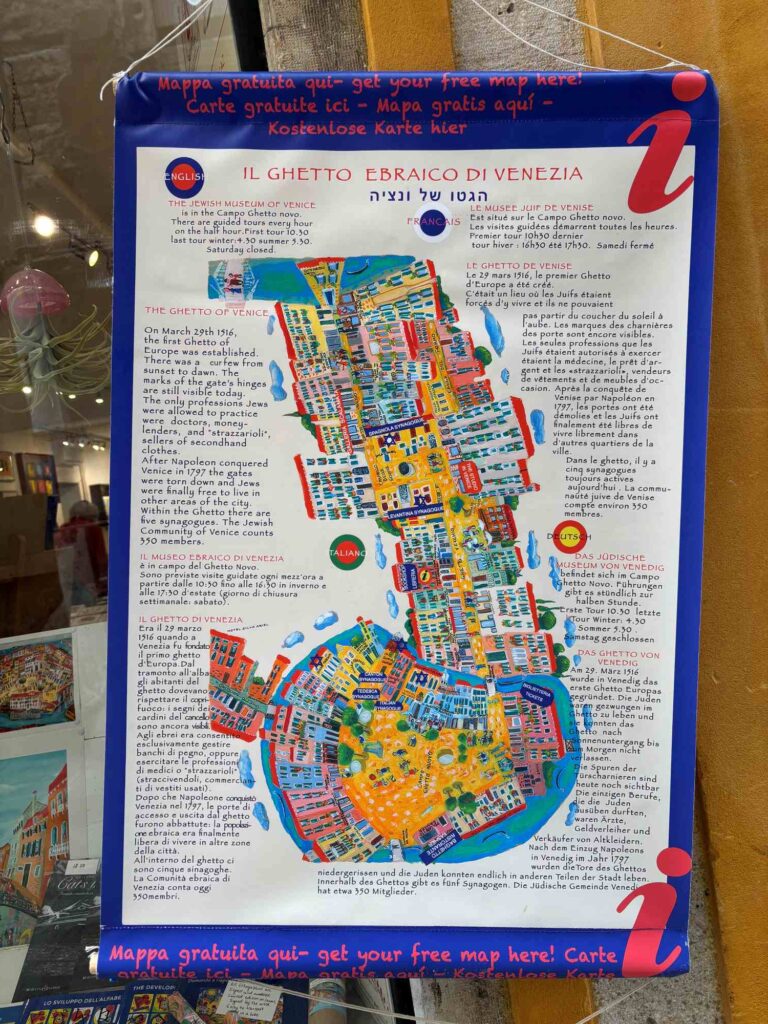
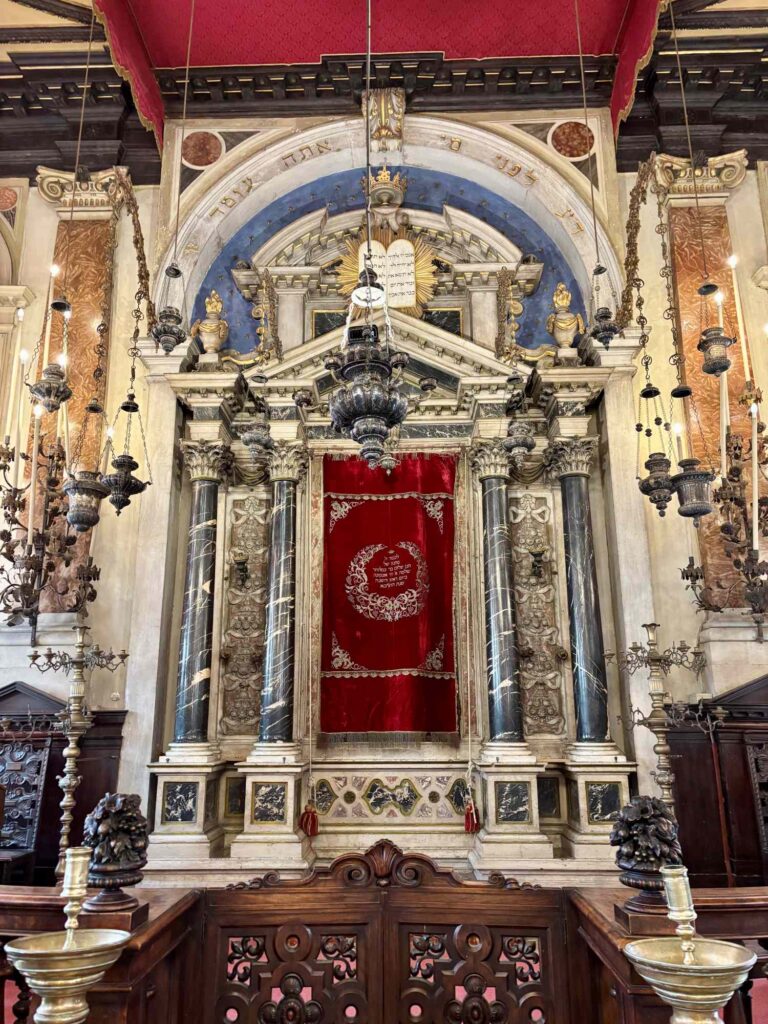
Venice’s Jewish Ghetto: A Walk Through History
Tucked among quiet canals and narrow alleyways, the Ghetto di Venezia is widely recognized as the first official Jewish ghetto in the world. It was established on 29 March, 1516, when the Venetian Senate decreed that all Jews in Venice be confined to this designated area in Cannaregio, which was locked at night and patrolled. A strict sunset-to-sunrise curfew was enforced, and to this day, you can still see the hinges where the gates once stood.
Today, the Jewish community in Venice numbers around 350 people, and the area is slowly evolving. It’s now home now to artists, students, and a handful of kosher bakeries, synagogues, and small shops that continue to preserve its unique character.
Guided Tour of the Synagogues
We bought tickets to the Jewish Quarter Guided Tour, which included a 45-minute guided tour in English. The tour was informative and thoughtfully paced, even for the kids. We visited two of the area’s five synagogues: the Levantine Synagogue, built in the 1530s, and the Spanish Synagogue, built later in the 16th century. From the outside, you’d never guess these buildings are places of worship. The facades are intentionally discreet but inside they are ornate and deeply atmospheric, full of history and symbolism. The guide shared powerful stories and historical context in a way that felt appropriate for younger visitors.
A Final Lunch & Off to Florence
After the tour, we had a quick pizza lunch at Strazzaria. This casual spot right next to the Ghetto had surprisingly good pizzas. Then, we made our way back to the train station to collect our bags. With that, it was time to say goodbye to Venice. We boarded our afternoon train to Florence, full of new memories. Venice had surprised us in all the right ways.
Next stop: Florence with kids!
Final Thoughts on Venice with Kids
Looking back on our four days in Venice, I’m so glad we made the decision to slow down and explore the city properly, rather than rushing through in a day or two. With its maze of bridges, car-free streets, endless gelato stops, and boat rides in every direction, Venice turned out to be a surprisingly easy and endlessly fascinating destination to visit with kids. Each day brought something different and the kids were just as captivated as we were. Sure, there were crowds and plenty of walking, but also quiet corners and magical moments we’ll all remember. If you’re wondering whether Venice is worth it with kids in tow – my answer is an easy yes!
I hope this article has been helpful to plan your trip to Venice with kids or inspire you for your next family trip. If you’ve been to Venice, let me know what you thought of it.
Follow me on Instagram for more travel inspiration and ideas for places to visit with kids.
Disclosure: This post contains affiliate links and I receive a commission if you visit a link and buy something on my recommendation. Purchasing via an affiliate link doesn’t cost you any extra, and I only recommend products and services I trust. All opinions are my own. As an Amazon Associate I earn from qualifying purchases. For more details see my disclaimer and privacy policy.

